
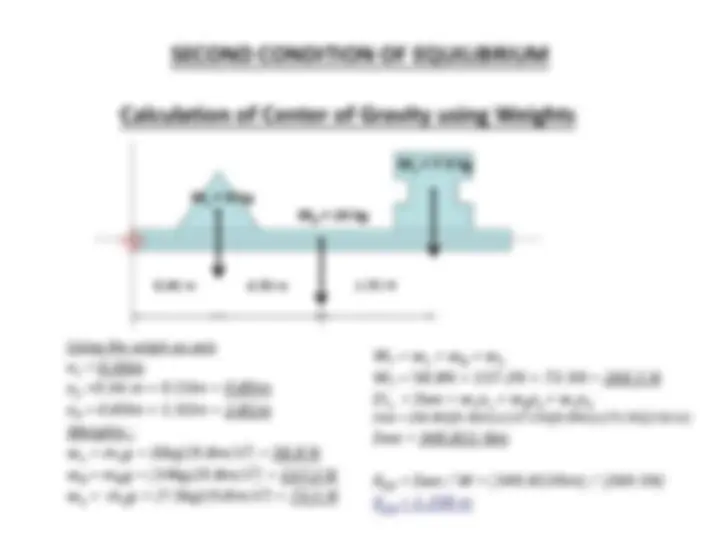
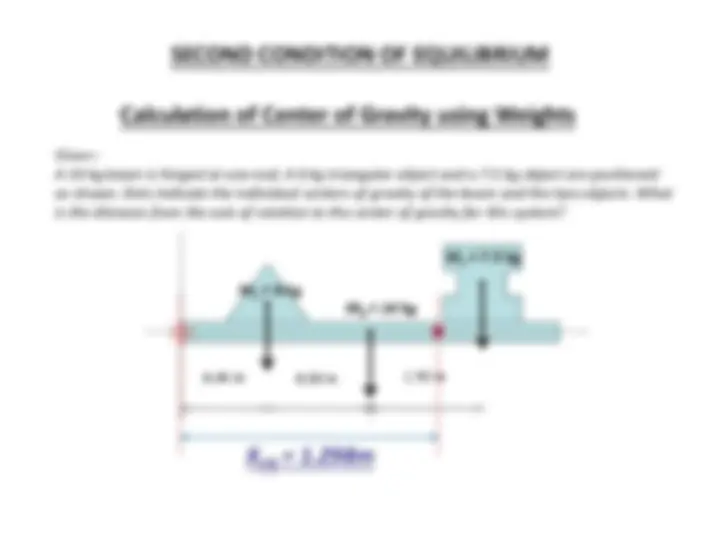
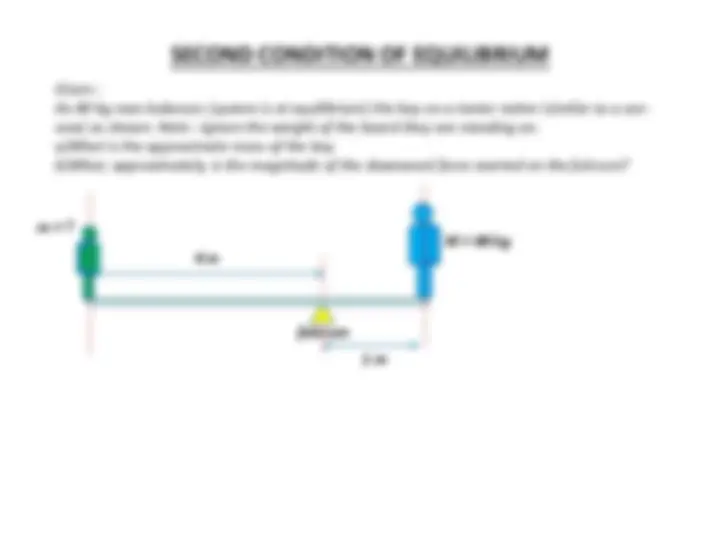
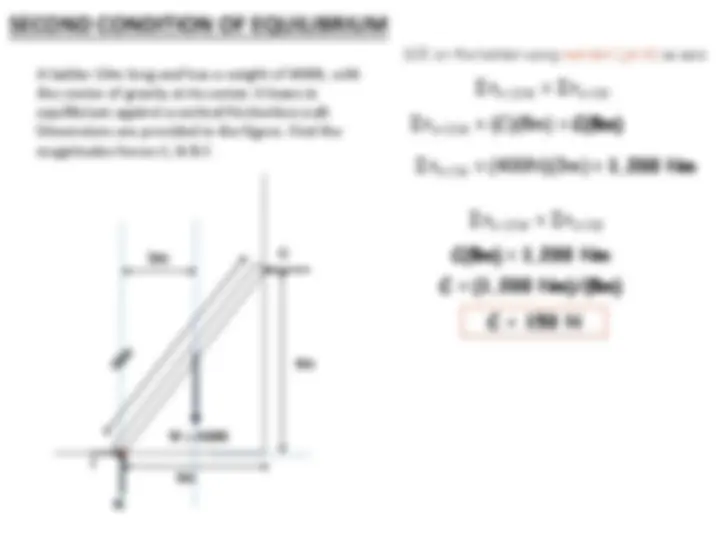
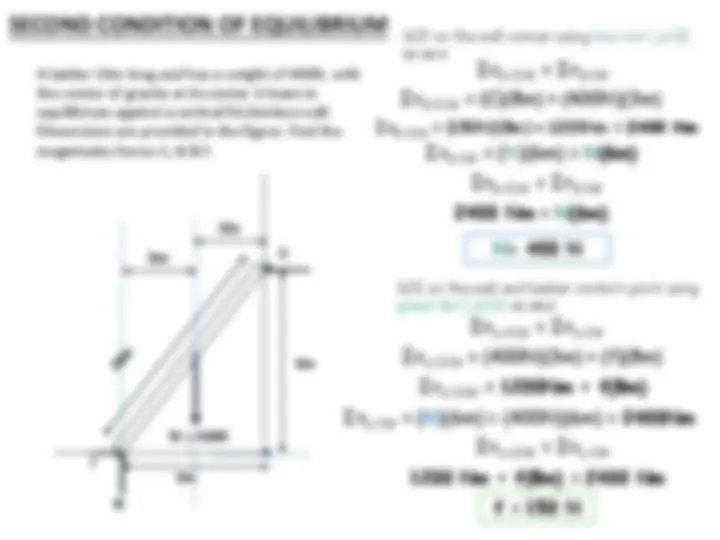
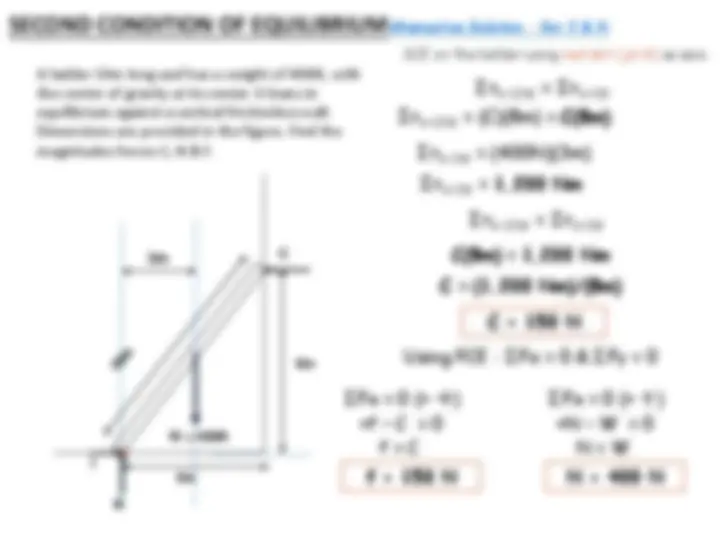
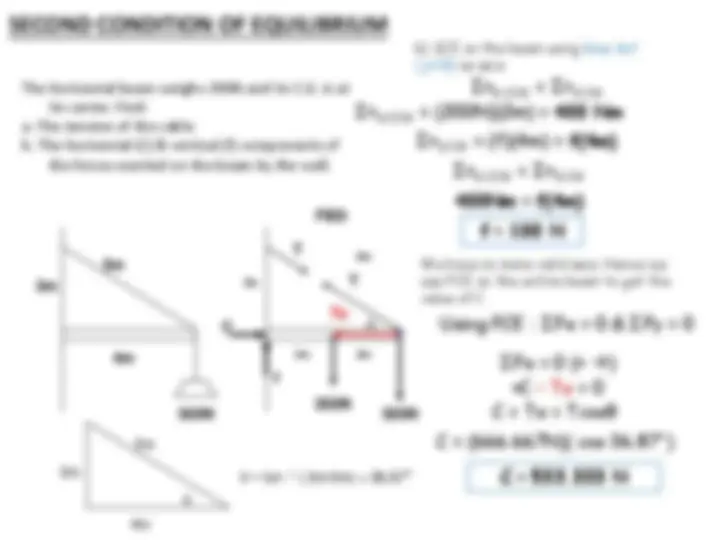
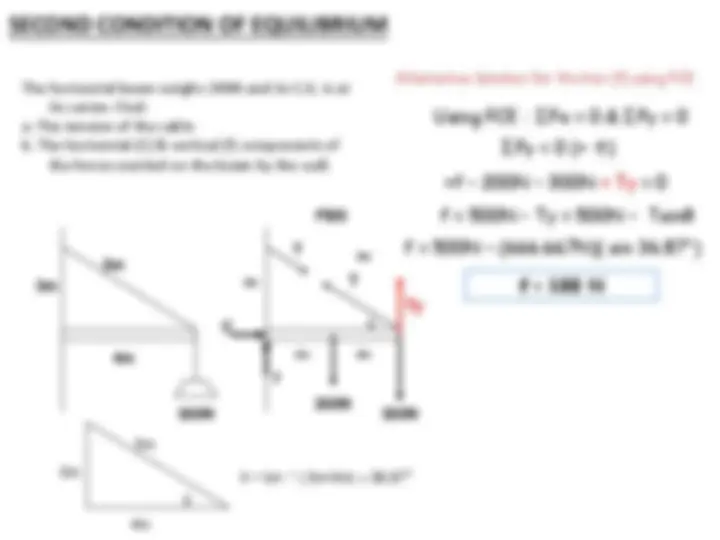
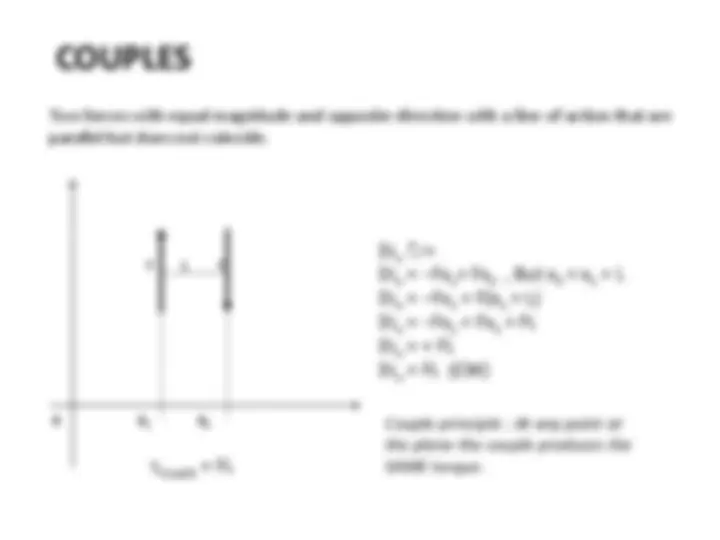
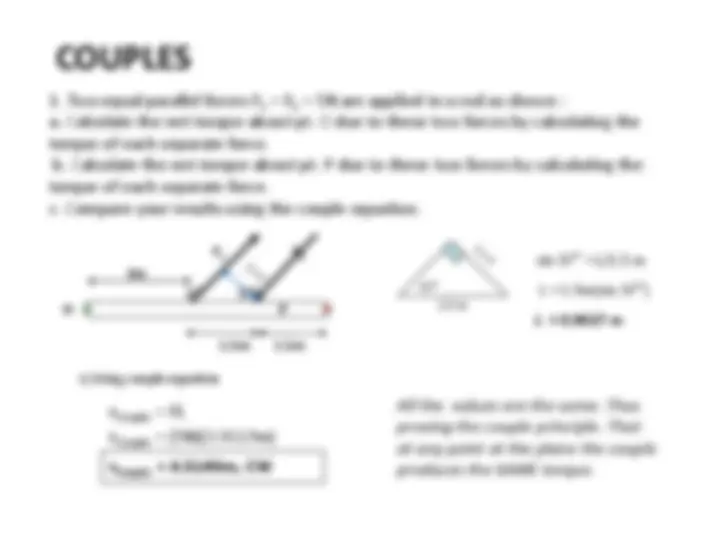


Study with the several resources on Docsity

Earn points by helping other students or get them with a premium plan


Prepare for your exams
Study with the several resources on Docsity

Earn points to download
Earn points by helping other students or get them with a premium plan
Community
Ask the community for help and clear up your study doubts
Discover the best universities in your country according to Docsity users
Free resources
Download our free guides on studying techniques, anxiety management strategies, and thesis advice from Docsity tutors
The concept of equilibrium and center of gravity in physics. It provides formulas and examples to calculate the center of gravity and solve problems related to equilibrium. The document covers topics such as calculation of center of gravity using weights, couples, and magnitudes of forces. It also includes examples of problems related to teeter-totter, ladder, and beam. useful for students studying physics and mechanics.
Typology: Lecture notes
1 / 18

This page cannot be seen from the preview
Don't miss anything!











Where w 1 , w 2 - weight of individual element x 1 , x 2 – lever arm of individual element with respect to x-axis y 1 , y 2 – lever arm of individual element with respect to y-axis ΣW – total weight of composite body X,Y - coordinate of the center of gravity
For simplicity : One of the axes can be graphically set to zero, IF the composite body is PURELY horizontal or vertical in structure, such that we only need to solve for one coordinate Calculation of Center of Gravity using Weights
Calculation of Center of Gravity using Weights Solution : Since the body is purely horizontal. We can set the Y coordinate for the C.G. to zero and solve only for X coordinate. Place the composite body at the center of the Y= 0 and one end of it at X=0 : Hence YCG = 0 Given : A 14 kg beam is hinged at one end. A 6 kg triangular object and a 7.5 kg object are positioned as shown. Dots indicate the individual centers of gravity of the beam and the two objects. What is the distance from the axis of rotation to the center of gravity for this system? M 1 = 6 kg M 2 = 7.5 kg MB = 14 kg
Calculation of Center of Gravity using Weights Given : A 14 kg beam is hinged at one end. A 6 kg triangular object and a 7.5 kg object are positioned as shown. Dots indicate the individual centers of gravity of the beam and the two objects. What is the distance from the axis of rotation to the center of gravity for this system? M 1 = 6 kg M 2 = 7.5 kg MB = 14 kg X CG = 1.298m
Given : An 80 kg man balances (system is at equilibrium) the boy on a teeter-totter (similar to a see- saw) as shown. Note : Ignore the weight of the board they are standing on. a)What is the approximate mass of the boy b)What, approximately, is the magnitude of the downward force exerted on the fulcrum? 4 m M = 80 kg fulcrum 1 m m =?
Given : An 80 kg man balances (system is at equilibrium) the boy on a teeter-totter (similar to a see- saw) as shown. Note : Ignore the weight of the board they are standing on. a)What is the approximate mass of the boy b)What, approximately, is the magnitude of the downward force exerted on the fulcrum? L 1 =4 m M = 80 kg fulcrum L 2 =1 m m =? b) Using the first condition of equilibrium ΣFY = 0 +↑
- F – WBm – WM = 0
2
2
Considering only the magnitude
F =? WM WB
SCE on the ladder using red dot ( pt.A) as axis ΣτA CCW = ΣτA CW ΣτA CCW = (C)(8m) = C(8m) ΣτA CW = (400N)(3m) = 1,200 Nm ΣτA CCW = ΣτA CW C(8m) = 1,200 Nm C = (1,200 Nm)/(8m) C = 150 N N f C W = 400N 6m 8m 3m A ladder 10m long and has a weight of 400N, with the center of gravity at its center. It leans in equilibrium against a vertical frictionless wall. Dimensions are provided in the figure. Find the magnitudes forces C, N & f.
SCE on the ladder using red dot ( pt.A) as axis ΣτA CCW = ΣτA CW ΣτA CCW = (C)(8m) = C(8m) ΣτA CW = (400N)(3m) ΣτA CW = 1,200 Nm ΣτA CCW = ΣτA CW C(8m) = 1,200 Nm C = (1,200 Nm)/(8m) C = 150 N Using FCE : ΣFx = 0 & ΣFy = 0 ΣFx = 0 (+ ) +f – C = 0 f = C f = 150 N ΣFx = 0 (+ ↑) +N – W = 0 N = W N = 400 N Alternative Solution : for f & N N f C W = 400N 6m 8m 3m SECOND CONDITION OF EQUILIBRIUM A ladder 10m long and has a weight of 400N, with the center of gravity at its center. It leans in equilibrium against a vertical frictionless wall. Dimensions are provided in the figure. Find the magnitudes forces C, N & f.
Two men are carrying a uniform ladder that is 5m long & weighs 100N. If one man applies an upward (lifting) force equal to 42N at one end. For the system to be at equilibrium: a) at what point should the other man lift? b) what should be the magnitude of F? a) SCE on the ladder using red dot ( pt.A) as axis ΣτA CCW = ΣτA CW ΣτA CCW = (100N)(x) ΣτA CW = (42N)(2.5m+x) ΣτA CCW = ΣτA CW (100N)(x) = (42N)(2.5m+x) (100N)X = 105Nm + (42N)X (58N)X = 105 Nm A B 42N (^) 100N 5 m F 2.5 m x X = 1.81 m (from the center) b) SCE on the ladder using blue dot ( pt.B) as axis ΣτB CCW = ΣτB CW ΣτB CCW = (F)(2.5m+x) ΣτB CCW = (F)(2.5m+1.81m) = F(4.31m) ΣτB CW = (100N)(2.5m) = 250 Nm ΣτB CCW = ΣτB CW F(4.31m) = 250 Nm F = 58 N
5m 4m 3m 300N 5m 2m 3m 300N 200N 2m T T f C FBD b) SCE on the beam using blue dot ( pt.B) as axis ΣτB CCW = ΣτB CW ΣτB CCW = (200N)(2m) = 400 Nm 3m 5m 4m θ θ = tan -^1 ( 3m/4m) = 36.87° ΣτB CW = (f)(4m) = f(4m) ΣτB CCW = ΣτB CW 400Nm = f(4m) f = 100 N We have no more valid axis. Hence we use FCE on the entire beam to get the value of C Using FCE : ΣFx = 0 & ΣFy = 0 ΣFx = 0 (+ ) +C – Tx = 0 C = Tx = Tcosθ Tx C = (666.667N)( cos 36.87°) C = 533.333 N θ The horizontal beam weighs 200N and its C.G. is at its center. Find: a. The tension of the cable b. The horizontal (C) & vertical (f) components of the forces exerted on the beam by the wall.
5m 4m 3m 300N 5m 2m 3m 300N 200N 2m T T f C FBD 3m 5m 4m θ θ = tan -^1 ( 3m/4m) = 36.87° Alternative Solution for friction (f) using FCE Using FCE : ΣFx = 0 & ΣFy = 0 ΣFy = 0 (+ ) +f – 200N – 300N + Ty = 0 f = 500N – Ty = 500N – Tsinθ Ty f = 500N – (666.667N)( sin 36.87°) f = 100 N θ The horizontal beam weighs 200N and its C.G. is at its center. Find: a. The tension of the cable b. The horizontal (C) & vertical (f) components of the forces exerted on the beam by the wall.